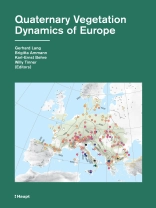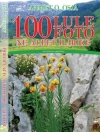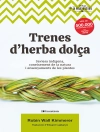Based on palaeoecological studies by many authors, this book gives an overview of the changing history of the European plant cover during the past 2.6 million years, characterized by numerous cold and warm periods. The period of the last 20 000 years (from the Last Glacial Maximum to the present) is presented in detail, with special emphasis on the vegetation dynamics of Europe, the history of selected woody plants, the development of lakes and bogs and the emergence of European cultural landscapes under the influence of humans over thousands of years.
In the analysis of the glacial and interglacial periods, the focus is on the different vegetation developments and the progressive impoverishment of the European flora. Further important topics are the spatio-temporal patterns and causes of long-term vegetation changes, the legacies of disturbances and land use on vegetation composition, the role of palaeoecology in nature conservation and its contribution to ecology and environmental sciences. In addition to recent research results, the book provides an overview of the main palaeoecological research methods. It concludes with a summary of the history of palaeoecology and Quaternary botany.
For the first time, a detailed synthesis is presented of the many findings on European vegetation dynamics, which are complex and increasingly difficult to summarize. Numerous figures and tables, many of them original, accompany the text. The bibliography includes over 3000 publications. This book is primarily intended for students, researchers and practitioners in plant ecology, palaeoecology, palaeoclimatology, forestry, agronomy, Quaternary sciences, climate sciences, biogeography, geography and archaeology.
表中的内容
Preface 8
1. An overview of the general framework of the development of flora and vegetation 11
1.1 Geology and geomorphology 11
1.2 Early development of flora and vegetation 13
1.3 Quaternary climate development and the consequences in terms of the position of coastlines 15
1.4 Changes of vegetation belts and decrease of floral elements in the course of the Pleistocene 17
1.5 The Holocene 18
1.6 Fauna and humans 19
2. Palaeoecological materials and methods 21
2.1 Introduction 21
2.2 Where: natural archives and their sampling 21
2.3 How: analysis of samples 25
2.4 When: dating techniques 40
2.5 What happened? Qualitative and quantitative changes: patterns 45
2.6 Why did it happen? Methods of inference: processes 48
2.7 Environmental reconstructions from pollen spectra 48
Box 1 Macrofossils and pollen 33
Box 2 Non-Pollen Palynomorphs for improved understanding of past environmental change 36
Box 3 Testate amoebae are a proxy for past hydrological dynamics and trophic status in peatlands 38
Box 4 Spheroidal carbonaceous particles 39
Box 5 Monitoring modern pollen deposition 50
Box 6 Roles of REVEALS and LOVE in the Landscape Reconstruction Algorithm (LRA) 64
Box 7 STEPPS: A Bayesian approach to quantifying trends and uncertainty in forest composition 66
Box 8 Estimating past plant abundances and pollen productivity from single pollen records with ROPES 69
3. Pleistocene history of vegetation and flora 73
3.1 Before the Pleistocene: the Tertiary 73
3.2 The Tertiary/Quaternary (Pliocene/Pleistocene) boundary and the subdivision of the Pleistocene 77
3.3 The Pleistocene in general 78
3.4 The Lower Pleistocene 85
3.5 The Cromerian 98
3.6 The Holsteinian and Wacken/Dömnitz 102
3.7 The Eemian 108
3.8 The Weichselian glacial period 120
3.9 The Quaternary history of some tree species 132
4. Late-glacial and Holocene vegetation changes and their causes 135
4.1 Stratigraphies and chronological subdivisions of the Late-glacial and the Holocene 137
4.2 Today’s vegetation and woody flora 145
4.3 Regional vegetation history 150
Box 9 Tree species migration models 247
4.4 History of selected taxa 249
4.5 Anthropogenic changes to the vegetation 363
4.6 Development of European lakes 409
4.7 Development of mires 426
4.8 Soil development and vegetation dynamics 451
4.9 Treeline and timberline dynamics 455
4.10 Long-term disturbance ecology 467
4.11 Causes of glacial-interglacial vegetation dynamics 486
5. Vegetation history, evolution and modern ecology 503
5.1 Introduction 503
5.2 Biotic responses to environmental change in the Quaternary 505
5.3 Nature of the plant ‘community’ 514
5.4 Pollen richness and diversity 517
5.5 Disturbance and the ‘intermediate-disturbance diversity’ hypothesis 521
5.6 Additional applications of Quaternary botany to modern ecology, biogeography and conservation biology 523
5.7 Future directions and challenges 525
6. History of the Quaternary vegetation sciences 529
6.1 Introduction 529
6.2 Quaternary geology in the 19th century 529
6.3 The first steps towards Quaternary vegetation history 530
6.4 Development of vegetation history in the 19th and early 20th centuries 530
6.5 Introduction and first steps of pollen analysis 531
6.6 Progress in pollen analysis 532
6.7 Peatland research 535
6.8 Archaeobotany 536
7. Appendices 543
7.1 Tables 543
7.2 Acknowledgements 560
8. Bibliography 563
Editors 687












